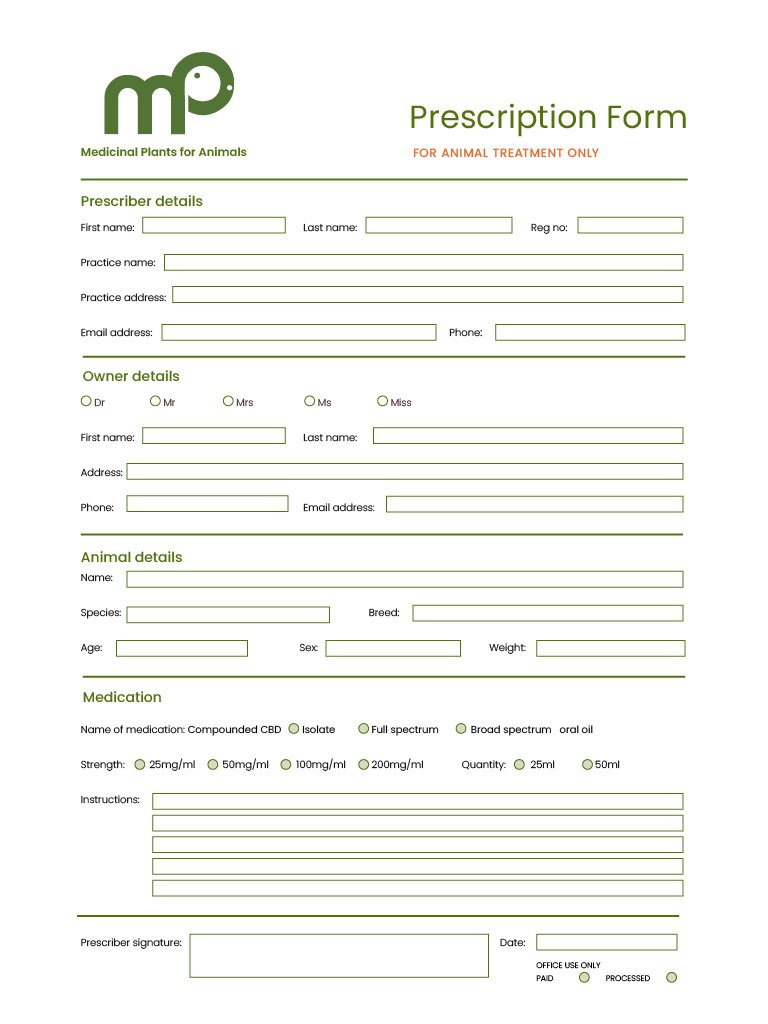Prescriptions
The following info pertains to liquid CBD for oral use.
What can I prescribe?
Vets can prescribe Category 1/Schedule 4 cannabis products without requiring any approval prior to dispensing.
You can prescribe isolate, broad spectrum and full spectrum CBD. Only full spectrum formulations contain TCH – to be classed as Category 1/S4, the TCH component must be <2%.
The most practical/least complicated way to do this is:
by writing a prescription for compounded CBD oil
having it processed through a compounding pharmacy with expertise in CBD for animal use (and has their products third-party quality tested).
This way you don’t have to try and navigate the products registered for human use and you have the support of a pharmacist who knows the laws around CBD for veterinary use.
What does my script need to include?
A CBD prescription is much the same as any other.
The script should state:
For animal treatment only
Prescriber's info: vet's name, address, contact number and professional registration number.
Patient's info: pet's name, species, breed, age and weight
Owner's infor: owner's name and contact details.
Date of issue: date the prescription is written.
Medication name: this should include the word compounded followed by formulation (isolate, broad spectrum or full spectrum) CBD oral oil
Medication strength: in mg/ml
Quantity: in ml
Dosing instructions: note that an initial prescription with have titration instructions whereas ongoing prescriptions usually don’t.
Specific instructions: Any special instructions regarding the medication's use.
Refills: If refills are allowed, the prescription should indicate how many.
Signature: veterinarian's signature.
Do I need to write CBD ‘dominant’ or >98%?
There’s no need. CBD isolate and broad spectrum have no THC in them. They are inherently CBD dominant. Full spectrum CBD contains THC, but as vets cannot prescribe anything other than products with >98% CBD, it is already implied.
Should I state the carrier oil?
It depends on your compounding pharmacy, but generally, they’ll have a default.
When it comes to carrier oils, there are pros and cons to both olive oil and medium-chain triglyceride (MCT) oil. MCT is thinner, milder in taste and may be absorbed faster (at least in humans). However, it can be sourced from palm oil (instead of coconut oil) and may cause digestive upset in some dogs.
Taste of carrier oil or added flavourings probably only matters when using CBD isolate, which is fairly flavourless itself. The inherent “earthy’ flavour of broad spectrum and full spectrum CBD is likely to overpower the oil or any additional flavourings.
We use olive oil and do not recommend any flavour additives.
CBD dose rate
As yet, there is no established standardised dosing for CBD in pets.
Dose suggestions here are based on published evidence and clinical experience.
A ‘typical’ starting dose for most patients and most conditions is 0.5mg/kg sid or bid.
A ‘typical’ therapeutic target dose is ~2mg/kg bid.
The transition to therapeutic dose is about 2 weeks. An example of titration is:
Day 1–3: Give 0.5mg/kg sid (often start at night)
Day 4–7: Give 0.5mg/kg bid
Day 8–10: Give 1mg/kg bid
Day 11–13: Give 1.5mg/kg bid
Day 14+: Give 2mg/kg bid
It can take 4 (or even 6) weeks to see full effect. You may want to keep your patient at the 2mg/kg dose for 2 weeks before increasing further.
Dosing guide based on condition treated
| CONDITION | Commonly used dose | Dose range | Initial dose |
|---|---|---|---|
| Osteoarthritis | 2–2.5mg/kg BID | 1–8mg/kg (high end for severe pain) BID to TID | Start with 0.5mg/kg SID or BID, increase by 0.5mg/kg every 3 days until desired effect is achieved. |
| Cancer | 3–5mg/kg BID | 3–10mg/kg BID to TID | Start with 0.5mg/kg SID or BID, increase by 0.5mg/kg every 3 days until desired effect is achieved. |
| Anxiety & cognitive dysfunction | 0.5–8mg/kg BID–TID | --- | Increase dose by 0.5mg/kg every 3 days as needed to achieve desired results (up to 8mg/kg BID-TID) *See below for further info |
| Phobias and stressful events | 5–10mg/kg one hour before the stressful event | --- | For thunderstorms (hard to predict): PRN dosing once event has started can significantly reduce stress response |
| Seizures | 2.5–10mg/kg BID (higher end of dosage range generally used short term) | --- | Starting dose can be higher and increase can occur quicker (every 24hours by 1mg/kg) if needed |
*For sleep-wake cycle disturbances, it's beneficial to administer the last dose just before bedtime, ideally as late as possible.
Points to note
Most patients will begin to see improvement within the first week. Further enhancement is possible with dose adjustments.
When using broad spectrum and full spectrum CBD, you might find improvements are seen at lower doses.
If a patient is doing well on a low dose, the dose does not have to be increased.
CBD can affect the metabolism of certain drugs, specifically those processed by Cytochrome P450 enzymes, such as macrolides, calcium channel blockers, benzodiazepines, cyclosporine, antihistamines, SSRIs, and tricyclic antidepressants, as well as opioids.
For patients on any of the drugs mentioned above, it's advised to increase the CBD dose very gradually. We suggest increments of no more than 0.5mg/kg per week, and sometimes even less. Regular weekly or bi-weekly check-ins, either in-person or via phone, are essential to monitor the effects and any potential side effects.
What strength to prescribe
Common strengths are 25mg/ml, 50mg/ml and 100mg/ml.
We also prescribe 200mg/ml rather than larger quantities.
You want to match the strength to the size of the patient – that sounds obvious, but it’s tempting to prescribe high-strength formulas as they are typically more cost-effective for your clients. This can result in owners trying to draw up impractical amounts, particularly when starting out.
| Patient weight (kg) | 5 | 10 | 20 | 35 |
|---|---|---|---|---|
| Dose range (mg/kg) | 0.5 – 2.0 | 0.5 – 2.0 | 0.5 – 2.0 | 0.5 –2.0 |
| Strength (mg/ml) | Dose in ml | |||
| 25 | 0.1 – 0.4 | 0.2 – 0.8 | 0.4 – 1.6 | 0.7 – 2.8 |
| 50 | 0.05 – 0.2 | 0.1 – 0.4 | 0.2 – 0.8 | 0.35 – 1.4 |
| 100 | 0.03 – 0.1 | 0.05 – 0.2 | 0.1 – 0.4 | 0.18 – 0.7 |
| 200 | 0.01 – 0.05 | 0.03 – 0.1 | 0.05 – 0.2 | 0.9 – 0.35 |
In practical terms, the minimum amount to give is 0.05ml (= 1 drop). Although 0.1ml is probably easier for most clients.
Hence, for an initial prescription, we recommend the following strengths:
5kg patient: 25mg/ml
10kg patient: 25mg/ml or 50mg/ml
20kg patient: 50mg/ml or 100mg/ml
35kg+ patient: 100mg/ml
For subsequent prescriptions, using ≥2mg/kg, you could consider increasing strength.
What amount to prescribe
When starting out with any medication that may be used long-term, it’s sensible to start with a small or trial amount and assess how the patient responds before prescribing more.
This is especially the case with an expensive, compounded medication that cannot be returned. (And yes, CBD is expensive).
That said, the initial prescription amount should cover at least the titration period (ie at least 2 weeks). As it can take 4 weeks or more to fully assess response, you may want to consider prescribing a month’s supply.
| Weight (kg) | Strength (mg/ml) | 25ml Bottle (days) | 50ml Bottle (days) |
|---|---|---|---|
| 5 | 25 | 38 | 69 |
| 50 | 76 | >100 | |
| 100 | >100 | >100 | |
| 10 | 25 | 19 | 34 |
| 50 | 38 | 69 | |
| 100 | 76 | >100 | |
| 20 | 25 | 9 | 17 |
| 50 | 19 | 34 | |
| 100 | 38 | 69 | |
| 35 | 25 | 5 | 10 |
| 50 | 9 | 19 | |
| 100 | 19 | 34 |
This table reflects roughly how long a 25ml or 50ml bottle would last different sized patients, accounting for a starting dose of 0.5mg/kg sid and titrating up every 3 days for 2 weeks.
For an initial prescription to last a suitable trial period, consider prescribing:
5kg patient: 25ml of 25mg/ml (will last approx 38 days)
10kg patient: 25ml of 50mg/ml (will last approx 38 days)
20kg patient: 50ml of 50mg/ml (will last approx 34 days)
35kg patient: 50ml of 100mg/ml (will last approx 34 days)
The maths is much easier once an ongoing daily dose is established!


